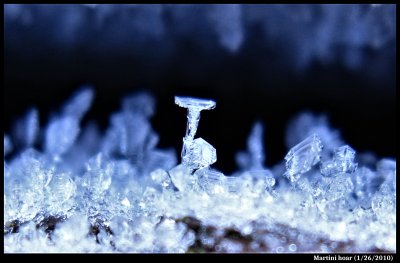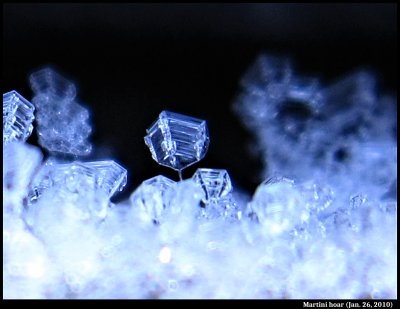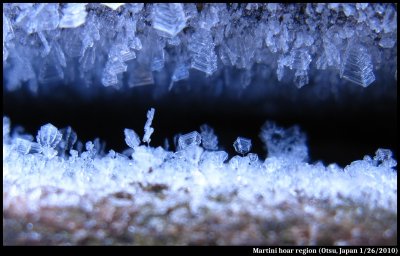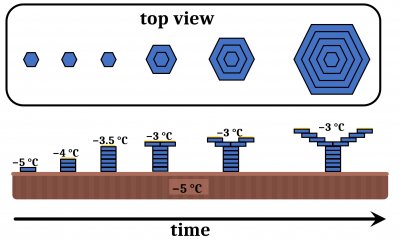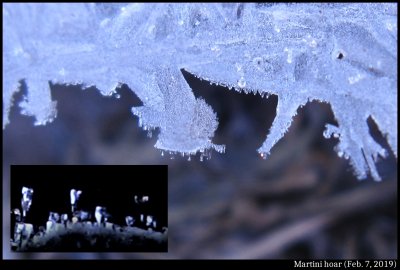| « The Growing Icicle's Hollow Tip | Drainage Lines on Snow » |
Martini Hoar (raise a tiny glass?)
The hoar-frost crystal shoots up like a thin, solid straw, then suddenly opens up into a cup-like shape. I have seen it often enough to give it a name: "martini hoar".
The cup can be weirdly segmented and polyhedral, but it nevertheless widens suddenly. Here are a few more (Sorry for poor photos—someday, I hope, I'll get better about photography.)
Here is a larger view of the region. Note the similar hoar coming down from the top, but without a clear view of the base.
This sudden widening feature has bothered me for awhile, but I was delighted the other day to figure out a plausible reason. My delight was made even greater because the reason involved measurements I made in the lab two decades back. The measurements were to understand snow-crystal habit, but apply equally well to hoar frost because hoar grows just like snow except it is attached to the ground.
Now that I have viewed some of the older pictures I took, the actual growth phenomenon looks more complicated in terms of crystal shape, so I am not so sure my reasoning explains things so simply. Nevertheless, it should apply well to many cases, and at least is worth learning because it involves important growth principles that also apply to snow.
From a growth perspective, the basic observation is that the fast-growth direction suddenly changes. As sketched in the figure below, the growth starts as a straight-up column or needle (look at the lower, or side, view):
After growing up a ways, the fast-growth direction shifts from straight up to outward. From this point on, the crystal broadens. The top view (sequence at top), shows a hollowed out "cup" shape developing. The sketch also shows approximate temperatures on the top of the crystal. As the crystal grows further from the cold surface, its outermost crystal faces warm up, from about -5 to -3 C.
The basic cup crystal (no "stem" on the glass) is quite common in hoar frost, and may even occur in falling snow. Nakaya put the cup shape into his snow-and-ice classification scheme, and subsequent classification systems have also included it. However, I think it is rare in falling snow because the humidity (specifically, the "supersaturation") cannot get very high in a cloud. On the ground surface, the local "humidity" can get higher because the ground cools significantly by radiative cooling. This difference between the hoar frost on the ground and the snow crystal in a cloud partly accounts for the greater variety of growth forms in hoar frost.
The figure below shows what I think is happening on the more fundamental crystal-growth-process level. (In the figure, the red and blue curves are approximate segments of my old measurements.)
The plot shows two thick curves. The horizontal blue curve (line) is the critical supersaturation for the prism faces: if the local humidity exceeds this value, then the prism face can rapidly grow. The red curve shows the same for the basal. Note that the red curve bends below and above the blue, suggesting curious temperature-dependent behavior on this face.
In our martini case, the ice column starts out (say) near -5 C (23 F). This is the brown circle. Here, the basal face has the lower critical value. The local humidity just exceeds this value because once the crystal face starts growing, it depletes the vapor, driving down the local humidity. As a result, the local humidity near the crystal cannot significantly exceed the lower critical value in general.
However, growth also liberates heat, warming the crystal, mostly at the growing (top) surface. As the crystal column grows longer, it warms up more because the growing surface is further from the cold ground surface to which it is anchored. At some point it may get close to the "crossover" temperature of -3 C (black dashed line). If it does reach close to this temperature, then its local humidity can rise above that needed for growth on both the basal and prism face. Here, and only here, the growth direction can point outward, causing the column to flare out into a cup. This is the green dot along the black curve. If the heating is even larger, the local humidity might even move into the red prism zone marked by the red dot. If this is the case, the cup flares out very quickly, being essentially only the prism-face (tabular) growth.
Other things are changing during the crystal's growth that will influence the shape, but I think the above heating process together with the surface temperature rise will always occur even though it may be too small in some cases to alter the crystal shape.
So, there should be a range here of possible cases, each yielding differently shaped cups. Some may be more like wine glasses, some more like martini glasses. But I prefer the sound of "martini".
Here is a more recent case from this past winter.
The inset shows an enlarged, inverted, background-subtracted, view of the hoar coming down from the ice near the middle. And finally, another one from Japan (2010):
The enlarged figure at left shows a region near the center of the larger image. I tried various photo-editing tricks to try to show the hoar shapes better. But in the end, what I really need are better photography skills (and maybe a better camera).
--JN
By the way, we are still behind on the funds to publish our research. If you can, consider contributing here:
https://www.gofundme.com/f/publish-a-research-paper-on-snowcrystal-formation
